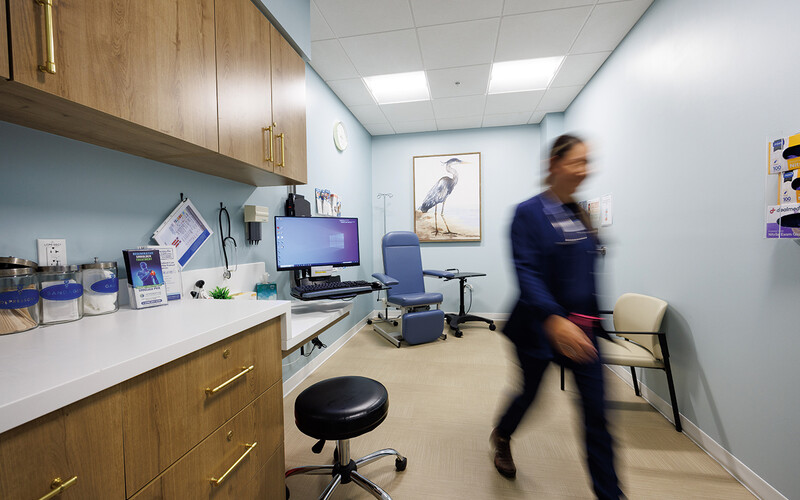How Can AI Support the Senior Care Workforce?

At Cypress Living in Fort Myers, Fla., clinicians consult with a custom-built chatbot named Hugo, driven by artificial intelligence (AI), to assist in developing interventions after a resident has experienced a fall. Clinicians can input some basic information about the fall, and Hugo will then guide them by suggesting structured, evidence-based interventions to support post-fall care. Team members rate each response, helping to improve the tool over time.
“Each time a resident experiences a fall in a skilled nursing facility, the facility must create an individualized care plan intervention to address identified risks and prevent future falls,” says Joe Velderman, vice president of innovation at Cypress Living. “Hugo can augment caregiver thinking by quickly assembling comprehensive intervention ideas, enabling clinicians to consider a wider array or solutions than they might otherwise develop independently.”
It’s an AI application that would have been unthinkable just a few years ago. And yet, Velderman notes, the technology available today is “the worst AI we’re ever going to see.”
A number of senior care organizations across the U.S. are actively experimenting with AI, not only for the efficiency benefits that AI tools can already provide but to prepare for future applications of what many have come to see as an era-defining technology.
Click the banner below to read the new CDW Artificial Intelligence Research Report.
For some time, AI has been operating in the background for the care of older adults, powering features in electronic health record systems and functional assessment tools, says Scott Code, vice president for LeadingAge’s Center for Aging Services Technologies.
However, the emergence of generative AI platforms has sparked a new wave of excitement, and Code notes that organizations are using the technology for applications ranging from social connectedness platforms to back-office operations.
But rather than adopting AI for its own sake, organizations should ensure their technology initiatives align with their larger missions, he adds.
“You shouldn’t be doing something just because everyone is talking about AI,” Code says. “Consider your priorities for the next three years and identify technologies to support those goals, whether they are AI-based or not.”
EXPLORE: Embrace generative AI and large language models in senior care.
At Cypress Living, Velderman says, up to 170 robotic process automations run every day throughout the organization, many of them via the Microsoft Power Automate platform, which creates automated workflows between various apps and services.
“Sometimes, it’s as simple as taking a paper form and saying, ‘We’re going to turn this into a digital form,’ and then automating the results of that form to an email,” he says. “We have hundreds of automated processes that run every day, and each one of those might save a phone call or some other human process. It adds up to hours every day.”
Kristina Troyer, a data scientist at Cypress Living, developed a machine learning model that can predict with better than 90% accuracy whether a resident is likely to experience a fall over the next three days, using data the organization was already collecting.
Eventually, Velderman says, robots may lift and transport residents in senior living communities, and workers may have their own “armies” of digital agents.
“I think many of our team members will shift from doing to supervising,” he says. “It’s going to be a very different mindset going forward.”








At Juniper Communities — which operates 28 communities in Colorado, New Jersey, Pennsylvania, Delaware and Texas — IT leaders are already using AI to boost back-office efficiency and resident services, while continuing to explore new ways to use the technology.
“Juniper sees AI as a tremendous opportunity to understand and personalize experiences when people come to a community,” says Don Breneman, COO and CTO for the organization. “We’re trying to collect as much information as we can to better understand the best programming features and provide the most optimized experience. Hopefully, that will mean residents will stay longer, be more satisfied and have better wellness outcomes.”
Juniper uses robots in its dining halls and for nightly cleaning. The organization has also integrated AI into its administrative workflows through Microsoft Teams and Copilot.
Breneman says the organization is taking care to organize data and information architecture and even uses specific metadata in file names to facilitate AI-powered enterprise search in the coming years.
DISCOVER: Harness the power of Copilot for Microsoft 365 in healthcare.
Already, he adds, Copilot is saving Juniper employees significant time in their daily work.
“Before, in my Outlook, you could search endlessly for a file you knew you used at some point,” Breneman says. “That could burn up 20 minutes or more of my time. Now, that search happens almost automatically. I think it’s a tremendous advantage.”
Looking ahead, Breneman plans to use AI to improve Catalyst, Juniper’s membership-based health and wellness program. Catalyst gives residents access to a lifestyle concierge, who helps them pick programs and activities that will help them meet their “well span” goals. By leveraging AI, Breneman hopes, Juniper will be able to better match program participants with the exact activities they will most enjoy, while also meeting their specific needs.
“Residents go to a multitude of providers, and all of them are doing different assessments,” he says. “You might go to your general practitioner, then you’ll go to a neurologist, then maybe your physical therapist. AI is fully capable of dynamically sorting that data in a way that can be used to create a pathway of care. We believe those recommendations can be highly personalized, not just in a clinical setting but in a holistic wellness model.”
The portion of U.S. adults who say using AI in healthcare will reduce provider mistakes
Richard Foor, vice president of IT at Givens Communities, which operates four senior communities in North Carolina, says that “AI is still marinating.”
“It’s really hard to find use cases that actually provide a financial or even an intangible benefit on a large scale. We’re trying to figure out where it’s going to take off and cause us all whiplash,” he adds.
To test out the technology, Givens designated a group of employees as “Copiloteers” to try out Microsoft Copilot, an AI tool that integrates with Microsoft applications such as Word and Outlook to help users summarize their content, find insights in their own data or generate new content based on existing resources.
During the first 90 days of the program, 60% of participants used the AI function in their normal workflows, and 56% said it increased their efficiency. Those numbers have since gone up, Foor says, and employees are now also using AI tools such as ChatGPT and Claude.
UP NEXT: CDW leverages AI To drive innovation and enhance customer experience.
“I would say, in the past six months, our use of AI has almost tripled,” he says. “It’s really exploded.”
Foor and his team are currently looking into building multiprocess AI agents on a small scale to determine how they might improve workflows such as employee onboarding. They are also building an improved internal chatbot. Currently, Givens has a platform that can respond to simple user queries, providing answers based on internal policy documents.
Foor is hoping that the next version can internalize the Givens “culture and personality,” doling out predictive guidance based on organizationwide data.
“Hopefully, it won’t just be automation,” Foor says. “We already have process automation. But doing automated processes with your culture and your corporate history in mind, that’s where you really start to see the benefit and the time savings. In 10 years, it might make decisions that a vice president would make.”
Though Foor isn’t sure which areas of senior care are most likely to be upended by AI, he says it is crucial for providers to prepare for what he sees as an inevitable transformation. “We want to expose our organization to AI in a responsible manner, with guardrails, so that when something comes along that changes everything, we’re ready for it,” he says.
healthtechmagazine





